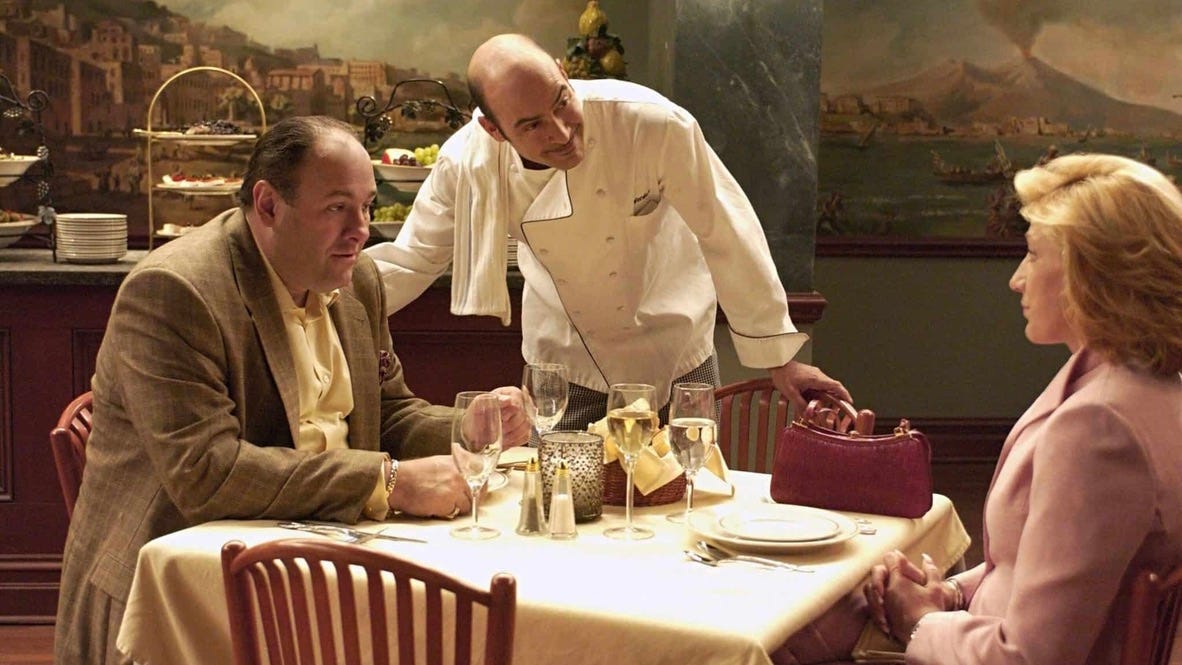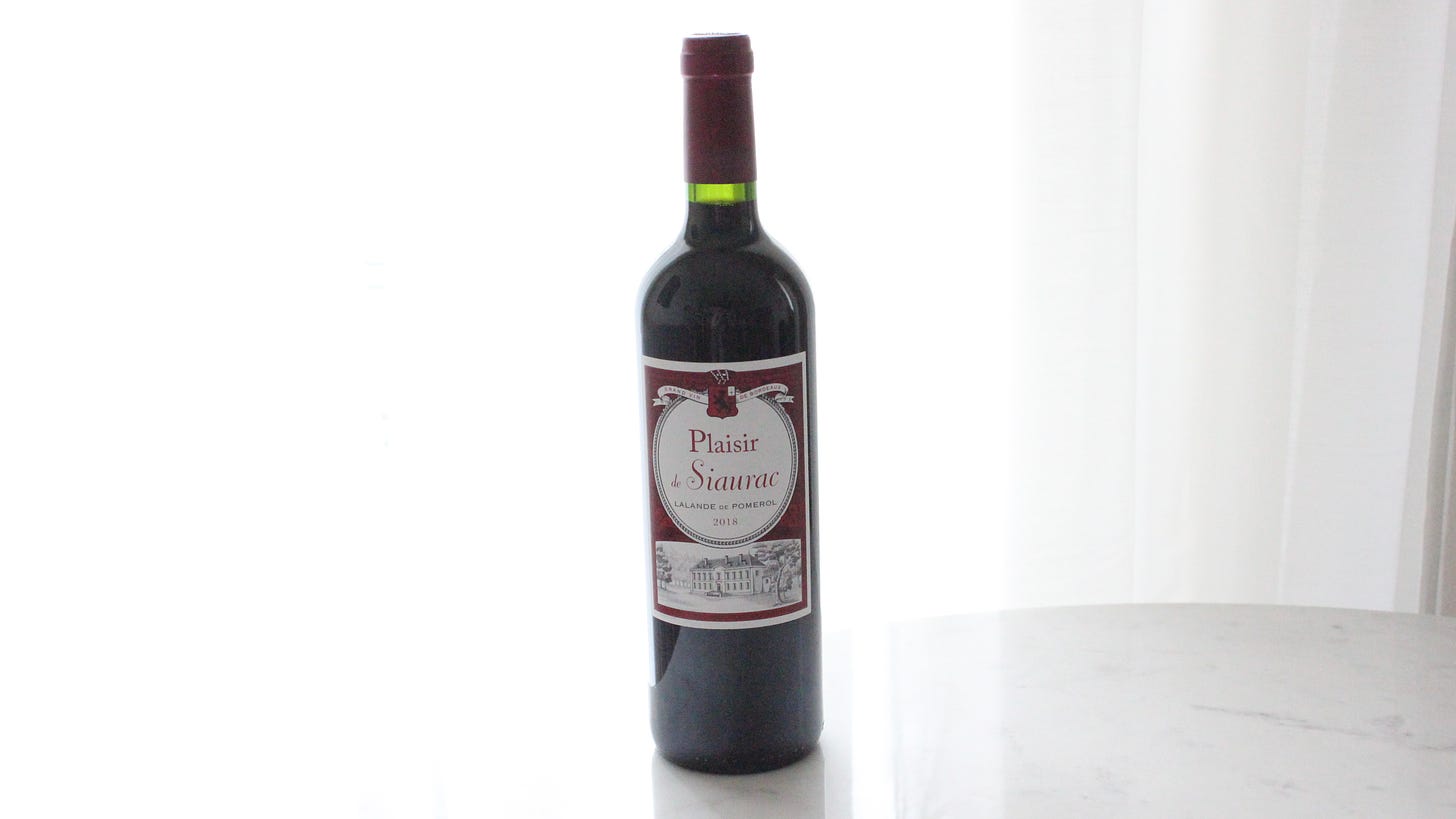Malcontent in the Middle
The letdown of dining somewhere between "cheap eats" and highbrow in an age of inflated prices and expectations. Plus, wines that remind me of the "nice-casual" restaurants of my Queens childhood.
Today’s newsletter is written by our new contributor Alexandra McInnis, who is co-creator of the Alpine Wine Society newsletter. Alexandra works at Crush Wine & Spirits in New York, and began her wine journey after a career in the film industry.
For the past couple of Friday nights we’ve spent together, my friend and I have had the same routine: Try out an inexpensive restaurant, and then share a pot of tea at Prince Tea House. On paper, it’s not the most thrilling Manhattan night out. But who cares when the most recent eatery happened to be Rowdy Rooster, which touts itself as the harbinger of “real full-fledged Indian Fried Chicken.” As great as the Lil Rowdy sandwich was (generously battered, robustly spiced dark meat dressed with scallion yogurt and mint chutney) it was the $4 eggplant pakora I couldn’t get out of my mind. It was delicate compared to the showier chicken—thinly sliced, gently crispy, with the excess seasonings blowing right off. It speaks volumes that something so simple and affordable could be so memorable. This may be “cheap” food, but the preparation suggests a high level of skill and care.
Rowdy Rooster sums up much of my dining out lately. Yet so does my single foray to Kolomon, the much-lauded French-Viennese restaurant that opened in the Ace Hotel last fall. There, my main course was also fried, but this time it was veal, pounded thin and puffed into a perfect little doily of a schnitzel. This is the type of traditional European cafe fare that could easily be maligned as a tired cuisine, except that at Koloman it gains a fresh intensity from the immaculate attention to detail which goes into it. The schnitzel, for example, began with a very high quality cut of meat, so tender that it eventually became one with the airy crust. Where the menu got more creative—celery root tartare, tafelspitz short rib terrine—it eschewed flightiness in favor of thoughtfulness—to the point where it was almost intellectual. Take, for example, the roasted beets “Linzer” with a hazelnut crust that will have me forever looking at the classic cookie differently. There were no cringey irreverent dishes. Nothing non-taco was was called a “taco,” for instance, which is a great way to feel trolled by an expensive restaurant. In short, it’s a place that takes both itself and its diners seriously.
$4 eggplant, $38 schnitzel…What’s been missing from my food budget has been brunch, midtown salad chains, and most of all the sort of middlebrow New American and fusion restaurants that constitute their own sub-genre of acceptable but unexciting good, where the menu features a token grass-fed burger with a signature sauce, and truffle oil finds its way onto the surface of at least one of the dishes. The few nods to international cuisines—bahn mi, falafel—feel more awkward than authentic, and the pastas are neither Italian in their refinement nor Italian-American in their portions. These are restaurants you seldom actually seek out; rather, you wander into them as a safe bet in a pinch, or fall back on them as respectable options if you need to meet someone in a certain neighborhood. Increasingly, these types of restaurants also feel like serious expenses, but without serious payoff.
A couple of weeks ago, Jason wrote about how paying just a little more for wine goes a long way. Curiously, dining out lately feels like the opposite: Pay a little more to reach a middlebrow restaurant tier and you feel like you’re getting less for your money. Suddenly you’re looking at kale Caesar adorned with a few slices of watermelon radish for over $20, or entrees featuring fried chicken that start around $30, or some other traditionally inexpensive Americana menu items (pork chops, grits, collards) prepared with some kind of half-hearted flourish and priced at a premium. The wine list may strive beyond the basic offerings (cabernet sauvignon, merlot and chardonnay), but even the glasses of chenin blanc or syrah are priced for at least as much as the bottles retail for—and you know what they retail for because you can find them almost anywhere.
Part of my avoidance comes from pure economic reality. It feels like inflation is stamped all over every drugstore and grocery receipt while wages remain constant. Which means that I, like so many others, need to scrimp where I can and carefully choose where I spend what’s left over. So why push my monthly budget over food I’m not excited about, and food that’s not that exciting to begin with?
The other part, though, is that I grew up in Queens, where these types of middlebrow restaurants didn’t exist for most of my childhood. The dining out scene mostly consisted of Irish pubs, Greek diners, and an abundance of non-American cuisines that invariably took the form of momo trucks, empanada counters, and Indian restaurants that felt more like someone’s living room. You found food that was flavorful, well-made, and ridiculously cheap. If you wanted to get fancy, you would “go into the city,” a ritual that had a charming kind of deliberateness to it, and makes me think of Carmela donning a skirt suit for date night in the early seasons of The Sopranos (seriously, I’ve been waiting my whole life to wear a skirt suit! Why hasn’t it happened yet?)
Yet another type of restaurant to be found in Queens, however, was perhaps a step towards the Manhattan style dining experience. This was the space occupied by the “nicer” Italian and Greek restaurants, as well as the old school, catch-all “continental dining” spots where filet mignon and chicken Milanese feature on the same menu. Anything out of the ordinary was more adornment than innovation, like risotto with pear and arugula, or spinach salad with goat cheese and candied pecans. It wasn’t the kind of food you would think about days after the fact, but it was enjoyable and sometimes very good, and if this is starting to sound like the middlebrow restaurants I’ve already claimed to have sworn off, part of the difference is that the staff wears bow ties and is trained to scrape the crumbs from the table in between courses.
Food, of course, is never any better because the person serving it is wearing a white shirt. But what is significant right now, or at least significant to me, is that the slight air of formality carries a clear message: This is a nice night out, or at least a nicer one, and not an everyday event. The menu likewise is heavy on foods that we’ve collectively deemed to be “fancy”: Shellfish, cream sauces, premium cuts of beef. The wine list allows the diner to order a glass or bottle based on a recognizable grape or wine region—the Bordeaux, the sauvignon blanc—for the purpose of a small bit of luxury that they know they’ll enjoy.
The nicer-but-not-extravagant restaurant would seem to have fallen out of fashion in recent years, perhaps as part of a rejection of anything deemed dated and stuffy, up there with indoor weddings and office dress codes. Cutting-edge, scientific-level gastronomy instead set the tone for the elevated dining experience, along with exciting new gourmet versions of foreign cuisines. Meanwhile the moderately well-heeled diner also seemed to acquire an appetite for food long thought of as working man’s fare, shelling out big(er) bucks for boutique barbecue and fried chicken. Yet I’m finding the white tablecloth restaurants of my youth reassuring at a time when everyday expenses are running so high, and in comparison to more contemporary places, where the ambiance and menu masquerades as casual, while the final bill is anything but.
A typical Friday night at Uncle Peter’s restaurant (“drawing inspiration from Italy, Spain & France”) on Northern Boulevard in Jackson Heights: The dining room is dotted with local couples, flanked by long tables reserved by families—with the women dressed to the nines, the men looking as though they’ve been coaxed into their nice pants, and the kids sitting firmly in their seats. Waiters swirl across the floor carrying cocktails plucked from a late-90s bar list, or platters of the daily seafood special, gilded with lobster and crab sauce, or a dessert with a candle pushed into it, because inevitably there are birthdays.
You know the waiters, because there’s not a lot of visible turnover with the staff. When you leave, there are about five staff members who materialize to bid you farewell, some with a handshake and a not insincere wish to see you again soon. I’m talking about the sort of places you can be remembered as a regular, even if you just go once in a while.
Below are some wines that remind me of this kind of casual-nice restaurant. They’re not overly ambitious or creative, but they’re honest about what they are. even a notch up from good.
Wines Most Likely Served By a Server In A Bow Tie
2018 Chateau Siaurac Plaisir de Siaurac (Lalande-de-Pomerol), $25
Bordeaux is, of course, a region where prices run the gamut, and I often find that the less expensive bottles lean too hard into fruity plushness. This merlot-and cabernet-franc-dominated blend is certainly offers lots of plum and cassis on the nose, but on the palate the fine tannins—approachable, but very much present—keep the wine sitting upright. At 14.5%, the abv is a little high for me, but admittedly it gives the wine some bigger energy. For the diner who wants an uncomplicated wine that feels a touch more serious to pair with their grilled sirloin steak.
2020 Thomas Frissant Le Chateau Comte (Touraine), $20
The cute little sketch on the label might suggest a natural wine, but don’t be fooled—this is a bottle that would live very comfortably on a classic restaurant wine list as “French Sauvignon Blanc.” Like almost every Loire Valley sauvignon blanc appellation that isn’t Sancerre, Touraine offers good value for the price. Le Chapeau Comte has a sunny, enveloping nose of softer citrus fruits (think tangerine and meyer lemon), while the palate offers sophisticated steely and tingling energy that separates Loire Valley sauvignon blanc from the others.
2019 Catena Malbec (Mendoza), $20
In wine it’s easy to dismiss “big production” as some kind of soulless endeavor, but occasionally some of the bigger names make a case for quality and consistency. Catena Malbec of the Bodega Catena Zapata dynasty could be an example. Perhaps it’s the high altitude vineyards creating a gentler expression of malbec, but there’s a silky harmony here to the flavors of oak, violets, and fruit. This is not a challenging, more “rustic” malbec, but it’s a pure pleasure to drink.









While you moved away from this theme mid way through, you reminded me of the description of certain restaurants as “premium mediocre “ I first read here...https://www.ribbonfarm.com/2017/08/17/the-premium-mediocre-life-of-maya-millennial/